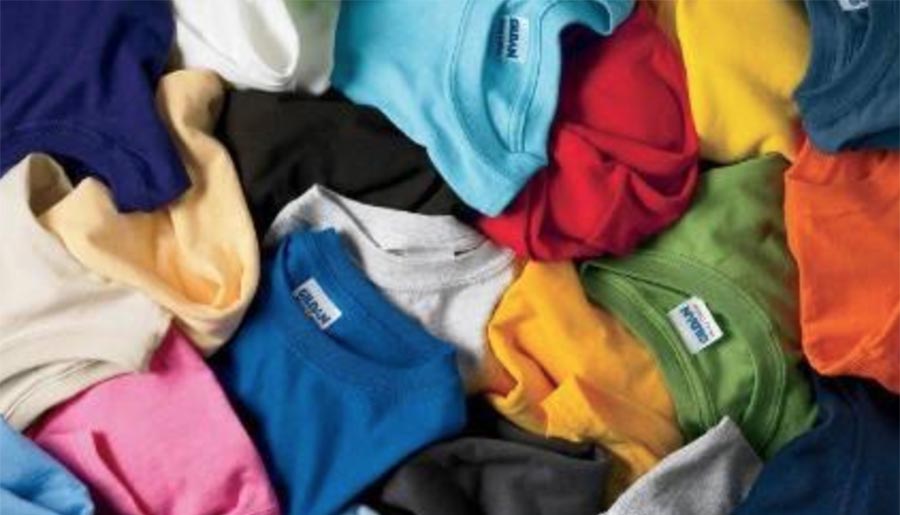Gildan Activewear reported a net loss of $99.3 million, or 50 cents per share, in the first quarter after tax charges of approximately $110 million, or 56 cents per share. Excluding charges, adjusted earnings were down 65.9 percent as sales dropped 26.4 percent.
“During the first quarter, we faced unprecedented impacts globally as the COVID-19 pandemic unfolded. This required us to amplify our focus on what we do best and on what we can do to support all our stakeholders as a values-driven, strong, resilient, and well-positioned company. I am both proud of and extend my gratitude to our employees for their dedication and efforts during this crisis which we will continue to move through over the coming months. I am also equally proud that in these difficult times, Gildan has been able to join with our partners to adapt rapidly to be able to produce products for the health care sector and people working in essential roles, as we all fight this global challenge,” said Glenn J. Chamandy, president and CEO.
Despite on-track performance during the first two months of the quarter, as global efforts to slow the transmission of COVID-19 heightened in March, Gildan said it started to see a significant downturn in demand for its core products, particularly in the imprintables channel where its products are typically used for promotional, sporting, entertainment, and other large-gathering and cultural events. In retail, Gildan said it also saw impacts, although less severe in the mass and online channels. Accordingly, total overall sales of $459 million in the first quarter were down 26 percent compared to the prior-year quarter. Gildan reported a GAAP loss per share of $0.50 for the first quarter compared to GAAP EPS of $0.11 in the first quarter of 2019, after reflecting total after-tax charges of approximately $110 million, or $0.56 per share.
These after-tax charges included a $92 million ($0.47 per share) impairment charge for goodwill and intangible assets acquired in previous business acquisitions related to its Hosiery cash-generating unit (CGU), restructuring and acquisition-related costs of $10 million ($0.05 per share), and a charge of $8 million ($0.04 per share) related to its stock-keeping unit (SKU) rationalization initiative. Before reflecting these charges, adjusted diluted EPS totaled $0.06 for the three months ended March 29, 2020, compared to 16 cents in the first quarter last year due mainly to the decline in sales, the impact of manufacturing and other costs related to the idling of facilities, which negatively impacted gross margin by 340 basis points or $0.08 per share, and an increase of approximately $21 million ($0.10 per share) in the allowance for expected credit losses to reflect heightened credit risk in the current economic environment. These factors were partly offset on a year-over-year basis by the impact of the trade accounts receivables impairment charge of $24 million, or $0.12 per share, related primarily to a distributor receivership, which occurred in the first quarter last year.
Company Actions To Address COVID-19
From the onset, as the situation of the COVID-19 pandemic unfolded, its first priority has been the health and welfare of its employees, customers, suppliers, and other partners. In this regard, Gildan said it has several actions to safeguard its stakeholders while ensuring the continuity of its business.
Concurrent with global government-mandated private sector shutdowns, Gildan said it began to close its manufacturing facilities starting on March 17, 2020, to ensure the safety of its employees and align its operations and inventory levels with the current demand environment. Since mid-April, Gildan said it extended the shutdown for almost all its manufacturing facilities. Some of its distribution centers, where Gildan said it has implemented enhanced measures to safeguard the health, safety, and well-being of its employees, continue to be operational at reduced capacity levels and the majority of its office employees are working remotely from home.
Starting in mid-April, in collaboration with various partners, Gildan said it began to produce protective personal equipment (PPE) to help address the shortage caused by the COVID-19 pandemic. Gildan said it is currently sewing face masks for a cooperative consortium of apparel and textile companies supplying non-medical face masks to the health care sector. Gildan said it is also producing non-medical face masks and isolation gowns for various retailers to be distributed to health care organizations. Gildan said it is currently planning to produce over 150 million masks and gowns to service the consortium and retailers under this effort. To ensure the safety and well-being of the employees working in the production of PPE, Gildan said it is has implemented stringent safety protocols.
In order to preserve cash and pre-emptively ensure that Gildan maintains ample liquidity to manage through the current and future environment, Gildan said it is deferring non-critical capital spend and discretionary expenses and have drawn down funds under its long-term bank credit facility. Further, on April 6, 2020, Gildan took additional cautionary measures to enhance liquidity by securing an additional $400 million of long-term debt with members of its existing bank syndicate. With the proceeds from the new debt financing, as of April 27, 2020, its overall available liquidity position was over $950 million comprised of cash on hand of over $650 million and available lines of credit of approximately $300 million.
Given the severity of the crisis and the uncertain economic outlook, out of an abundance of caution, Gildan suspended share repurchases and starting with the first quarter of 2020, Gildan said it also suspending the quarterly cash dividend. The company’s previously declared a quarterly cash dividend for the fourth quarter of 2019 was paid on April 6, 2020. Gildan said it remains committed to returning capital to shareholders through its dividend and share repurchases and expects to resume the programs when the environment normalizes.
Since March 30, 2020, the company’s Board of Directors, the company’s CEO, and Executive Vice Presidents have been foregoing 50 percent of their salaries and pay reductions ranging from 20 percent to 35 percent are also impacting its senior staff. Further, as of March 30, 2020, and until further notice, the majority of its salaried employees have moved to a four-day workweek.
Q1 2020 Operating Results
Sales for the first quarter of 2020 of $459.1 million were down 26.4 percent compared to the prior-year quarter, comprised of activewear sales of $372.6 million and sales in the hosiery and underwear category of $86.5 million, down 24.5 percent and 33.7 percent, respectively, over the prior-year quarter. While the company was anticipating an overall decrease in net sales for the first quarter, sales volume declines were meaningfully higher than previously anticipated due to the significant downturn in demand which unfolded in March as a result of the COVID-19 pandemic. Lower sales volumes were partly offset by favorable product-mix in the hosiery and underwear category and slightly higher net selling prices. The decrease in activewear sales reflected double-digit volume declines of imprintables in North America and in international markets, the impact of a sales return allowance of $6 million for anticipated product returns for discontinued SKUs, and lower activewear product sales in retail, as retailers increasingly closed stores during the quarter due to the COVID-19 pandemic. Similarly, sales in the hosiery and underwear category were also negatively impacted by retail store closures and declining store traffic trends as consumers adopted social distancing measures. The decline in sock sales also included the impact of its exit of a mass sock program and the non-recurrence of sock shipments related to the initial roll-out of a new private brand sock program in the first quarter of 2019. Underwear sales were down in the quarter due to the current challenging demand environment and the year-over-year impact of fully exiting a branded underwear program in the mass channel at the end of the first quarter of 2019, partly offset by an increase in sales of private brand men’s underwear in mass.
Its reported gross margin for the first quarter was 23.2 percent, down from 25.8 percent in the first quarter last year. Excluding the impact of an $8.0 million charge related to its SKU rationalization initiative as part of its Back to Basics strategy, its adjusted gross margin1 was 24.6 percent, down 120 basis points over the prior-year quarter. The decrease in gross margin was mainly due to labor and overhead costs, which were expensed as period costs in the quarter while production facilities were idled, as well as other costs incurred as a result of the COVID-19 pandemic, which together negatively impacted gross margin by 340 basis points and more than offset the benefit of cost savings from the company’s manufacturing optimization initiatives, favorable product-mix, lower promotional discounting and lower raw material costs compared to the first quarter of 2019.
SG&A expenses for the first quarter of 2020 totaled $73.9 million, down $19.1 million compared to SG&A expenses of $93.0 million in the same quarter last year due mainly to lower variable compensation costs, lower volume-related distribution costs, and cost containment efforts. Given the significantly lower sales base in the first quarter of 2020 compared to the same period last year, SG&A expenses as a percentage of sales were 16.1 percent in the quarter compared to 14.9 percent of sales in the prior-year quarter.
Although Gildan did not incur any customer-specific write-offs of trade accounts receivable during the quarter, the impairment of trade accounts receivable of $20.8 million was mainly due to an increase in the estimate for its allowance of expected credit losses, in light of heightened credit risk in the current economic environment. Further, due to the adverse impact of the COVID-19 pandemic on global economic activity and market capitalization of companies worldwide, including its impact on the company’s business and share price, Gildan recorded an impairment charge for its Hosiery CGU of $94.0 million in the first quarter of fiscal 2020, relating to goodwill and intangible assets acquired in previous sock and hosiery business acquisitions. Finally, restructuring and acquisition-related costs of $10.2 million in the first quarter of 2020 primarily related to the closure and relocation of its Mexican operations, costs related to the exit of ship-to-the piece activities and other manufacturing optimization activities initiated in 2019.
Consequently, after reflecting on these charges, Gildan incurred an operating loss of $92.3 million compared to an operating income of $32.7 million in the first quarter of 2019. After excluding restructuring and acquisition-related costs, charges related to the discontinued product SKU’s, and the impairment for goodwill and intangibles assets, adjusted operating income1 in the quarter totaled $19.9 million, down $23.4 million from $43.3 million in the first quarter of 2019. The decline reflected the lower sales base and lower gross margin, including approximately $16 million in manufacturing idling and other COVID-19-related costs.
Gildan reported a net loss of $99.3 million, or $0.50 per share on a diluted basis, for the three months ended March 29, 2020, compared to net earnings of $22.7 million, or $0.11 per share on a diluted basis, for the same period last year due to the operating loss incurred in the quarter. Excluding the impact of after-tax restructuring and acquisition-related costs, as well as the SKU rationalization, and goodwill and intangible assets impairment charges, adjusted net earnings in the quarter totaled $11.2 million, or $0.06 per share on a diluted basis, compared to adjusted net earnings of $32.8 million, or $0.16 per share on a diluted basis, in the first quarter last year, representing a decline of 65.9 percent. The decline in adjusted diluted EPS was mainly due to the decline in sales and adjusted operating margin.
The company consumed $235.0 million of free cash flow1 in the first quarter of 2020, compared to $127.8 million of free cash flow consumed in the first quarter last year. The free cash flow decline was mainly due to the decrease in earnings in the quarter and the build-up of working capital, including higher inventory levels due to planned inventory build in the first quarter. During the first quarter of 2020, capital expenditures were $25.6 million primarily for expenditures related to textile manufacturing and yarn-spinning operations.
During the first two months of 2020, Gildan repurchased 843,038 shares under its 2019 normal course issuer bid (NCIB) share buyback program at a total cost of $23.2 million. In order to preserve cash and proactively strengthen the company’s liquidity position, Gildan said it suspended share repurchases under its new 2020 NCIB program until further notice. In addition, Gildan announced today, the suspension of its quarterly dividend, starting with the first quarter of 2020. The company ended the first quarter of 2020 with net debt1 of $1,133.2 million and a leverage ratio1 of 2.2 times net debt to trailing twelve months adjusted EBITDA1. Subsequent to the end of the first quarter, on April 6, 2020, Gildan said it secured an additional $400 million of long-term debt with members of its bank syndicate positioning the company as of April 27, 2020, with over $950 million of liquidity.
Gildan said, “Given the significant impact of the pandemic and the resulting negative near-term economic outlook, we believe we have acted quickly to enhance our financial flexibility and strengthen its positioning to navigate through this unprecedented environment.”
Outlook
Due to the unprecedented nature and uncertainty related to the impacts of COVID-19, the company withdrew its guidance for 2020 on March 23, 2020. The demand deterioration that Gildan started to see in March has increased through the month of April with POS levels in the North American imprintables channel down approximately 75 percent. Sell-through trends in retail, including with global lifestyle brand customers, have also deteriorated, with overall retailer POS for its products in April down approximately 45 percent. Based on this situation and the expectation that COVID-19 social distancing measures and related economic impacts will have a significant impact on demand during the quarter, Gildan said it is planning for a significant decline in point of sale (POS) and shipments for the second quarter of 2020. Accordingly, this sales outlook combined with the impact of fixed cost absorption, while its manufacturing facilities remain idle, will likely result in a significant earnings loss in the second quarter of 2020.
Gildan concluded, “Nonetheless, despite this challenging near term situation and uncertain outlook related to the duration of the ongoing impacts from the pandemic, we believe we are well-positioned to deal with this environment for an extended period. In addition to its strong liquidity position, we have good inventory levels to service its customers in both retail and imprintables. We have extended the shutdown of its manufacturing operations until further notice and we will continue to assess the need and timing to resume manufacturing operations, while following government-mandated restrictions, in relation to evolving demand trends and inventory levels. We have taken steps to reduce our monthly fixed costs and expect to further lower our expenses as we move forward and adjust to a weak demand outlook which could extend through the remainder of the year.
“Overall, during this pandemic, Gildan has acted swiftly to protect the health and well-being of our people and to ensure the continuity and long-term positioning of our business. This follows initiatives that we have been implementing over the last two years under our Back to Basics strategy to simplify and lower our cost structure. We have a history of successfully navigating through challenging environments and Gildan said it is confident that our strong business model, financial position, resilience, and our capability to adapt to changing environments, will continue to position us well for long-term success when we emerge from this global crisis.”
Photo courtesy Gildan















